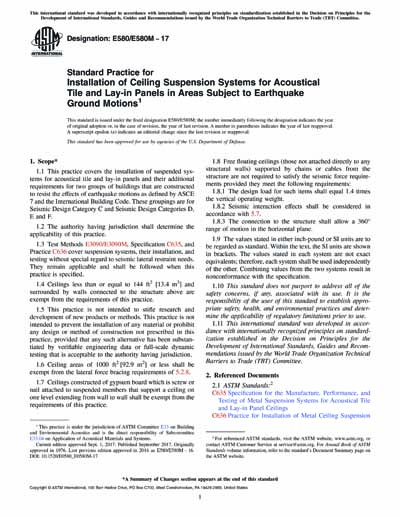Historical
ASTM E580/E580M-17
Standard Practice for Installation of Ceiling Suspension Systems for Acoustical Tile and Lay-in Panels in Areas Subject to Earthquake Ground Motions
1.1 This practice covers the installation of suspended systems for acoustical tile and lay-in panels and their additional requirements for two groups of buildings that are constructed to resist the effects of earthquake motions as defined by ASCE 7 and the International Building Code. These groupings are for Seismic Design Category C and Seismic Design Categories D, E and F.
1.2 The authority having jurisdiction shall determine the applicability of this practice.
1.3 Test Methods E3090/E3090M, Specification C635, and Practice C636 cover suspension systems, their installation, and testing without special regard to seismic lateral restraint needs. They remain applicable and shall be followed when this practice is specified.
1.4 Ceilings less than or equal to 144 ft2 [13.4 m2] and surrounded by walls connected to the structure above are exempt from the requirements of this practice.
1.5 This practice is not intended to stifle research and development of new products or methods. This practice is not intended to prevent the installation of any material or prohibit any design or method of construction not prescribed in this practice, provided that any such alternative has been substantiated by verifiable engineering data or full-scale dynamic testing that is acceptable to the authority having jurisdiction.
1.6 Ceiling areas of 1000 ft2 [92.9 m2] or less shall be exempt from the lateral force bracing requirements of 5.2.8.
1.7 Ceilings constructed of gypsum board which is screw or nail attached to suspended members that support a ceiling on one level extending from wall to wall shall be exempt from the requirements of this practice.
1.8 Free floating ceilings (those not attached directly to any structural walls) supported by chains or cables from the structure are not required to satisfy the seismic force requirements provided they meet the following requirements:
1.8.1 The design load for such items shall equal 1.4 times the vertical operating weight.
1.8.2 Seismic interaction effects shall be considered in accordance with 5.7.
1.8.3 The connection to the structure shall allow a 360° range of motion in the horizontal plane.
1.9 The values stated in either inch-pound or SI units are to be regarded as standard. Within the text, the SI units are shown in brackets. The values stated in each system are not exact equivalents; therefore, each system shall be used independently of the other. Combining values from the two systems result in nonconformance with the specification.
1.10 This standard does not purport to address all of the safety concerns, if any, associated with its use. It is the responsibility of the user of this standard to establish appropriate safety, health, and environmental practices and determine the applicability of regulatory limitations prior to use.
1.11 This international standard was developed in accordance with internationally recognized principles on standardization established in the Decision on Principles for the Development of International Standards, Guides and Recommendations issued by the World Trade Organization Technical Barriers to Trade (TBT) Committee.
ASTM International [astm]

